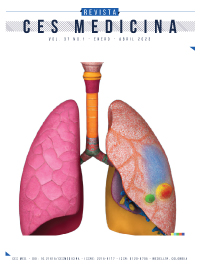Maternal and perinatal clinical outcomes among patients treated with antimicrobials for suspected subclinical intra-amniotic inflammation/ infection
DOI:
https://doi.org/10.21615/cesmedicina.6936Keywords:
infection, inflammation, amniotic fluid, antimicrobialsAbstract
Introduction: preterm birth is an important underlying cause of perinatal morbidity and mortality; one of the primary etiologies is intra-amniotic inflammation/infection, which are associated with adverse perinatal outcomes. The purpose of this study was to assess the relationship between antimicrobial treatment and maternal, fetal, and perinatal clinical outcomes in pregnant patients with suspected intra-amniotic inflammation/infection seen at a nationally- and internationally- recognized university hospital for high-risk obstetric cases in Medellín, Colombia. Methods: the researchers conducted an ambispective cohort study of singleton pregnancies with gestational ages > 24 weeks seen at the Clínica Universitaria Bolivariana (CUB) with suspected subclinical intra-amniotic inflammation/infection between January 2011 and December 2021 (n=75). The relationship between the use of antimicrobial treatment and maternal and perinatal clinical outcomes. Results: after conducting an analysis of clinical, para-clinical and laboratory evidence, the most statistically significant findings included abdominal pain, acute vaginal bleeding, and the presence of amniotic fluid “sludge” found during ultrasound cervicometry. The use of antimicrobial therapy was 1.88 times more common among patients with amniotic fluid “sludge” when compared to those without the presence of this clinical finding (CI 95% 1.23 to 2.88), p=0.0009; it was 1.43 times more common among patients experiencing uterine dynamics (CI 95% 1.06 to 1.94), p=0.050. The median difference of leukocytes in amniotic fluid showed an excess of leukocytes per field in patients who received antimicrobials, a difference of 9 leukocytes (CI 95% 5 to 25), p <0.0001. Preterm labor was more frequent in patients in whom there was a clinical indication for the use of antimicrobials (RR 1,58 IC95% 0,96- 2,61). After adjusting the analysis by time of latency between the suspicion of infection and labor, it was observed that the use of antimicrobials reduced the rish of preterm labor by 46% RR 0,54 (IC95% 0,35- 0,83). In culture-positive patients, the median latency period until birth was 4 (IQR 0-9 weeks) and 11 (IQR 8-15 weeks) in culture-negative patients, with a median difference of 6 weeks (CI 95% 1 to 10). Conclusion: among patients with suspected intra-amniotic inflammation/infection, antimicrobial therapy is associated with a lower risk for preterm birth, and lower latency period among culture-positive patients.
Downloads
References
Batura R, Colbourn T. A stitch in time: narrative review of interventions to reduce preterm births in Malawi. International Health. 1 de mayo de 2020;12(3):213-21.
Vogel JP, Chawanpaiboon S, Moller AB, Watananirun K, Bonet M, Lumbiganon P. The global epidemiology of preterm birth. Best Practice & Research Clinical Obstetrics & Gynaecology. octubre de 2018;52:3-12.
Chalupska M, Kacerovsky M, Stranik J, Gregor M, Maly J, Jacobsson B, et al. Intra-Amniotic Infection and Sterile Intra-Amniotic Inflammation in Cervical Insufficiency with Prolapsed Fetal Membranes: Clinical Implications. Fetal Diagn Ther. 2021;48(1):58-69.
Romero R, Miranda J, Chaiworapongsa T, Chaemsaithong P, Gotsch F, Dong Z, et al. Sterile intra-amniotic inflammation in asymptomatic patients with a sonographic short cervix: prevalence and clinical significance. The Journal of Maternal-Fetal & Neonatal Medicine. 24 de julio de 2015;28(11):1343-59.
Yoon BH, Romero R, Park JY, Oh KJ, Lee J, Conde-Agudelo A, et al. Antibiotic administration can eradicate intra-amniotic infection or intra-amniotic inflammation in a subset of patients with preterm labor and intact membranes. American Journal of Obstetrics and Gynecology. agosto de 2019;221(2):142.e1-142.e22.
Jung E, Romero R, Yeo L, Diaz-Primera R, Marin-Concha J, Para R, et al. The fetal inflammatory response syndrome: the origins of a concept, pathophysiology, diagnosis, and obstetrical implications. Seminars in Fetal and Neonatal Medicine. agosto de 2020;25(4):101146.
Rivera Z R, Caba B F, Smirnow S M, Aguilera T J, Larraín H A. Fisiopatología de la rotura prematura de las membranas ovulares en embarazos de pretérmino. Rev chil obstet ginecol [Internet]. 2004 [citado 4 de mayo de 2022];69(3). Disponible en: http://www.scielo.cl/scielo.php?script=sci_arttext&pid=S0717-75262004000300013&lng=en&nrm=iso&tlng=en
Gibbs RS, Castillo MS, Rodgers PJ. Management of acute chorioamnionitis. American Journal of Obstetrics and Gynecology. marzo de 1980;136(6):709-13.
Espitia-De La Hoz FJ. Diagnóstico y tratamiento de la corioamnionitis clínica. Rev Colomb Obstet Ginecol. 30 de septiembre de 2008;59(3):231-7.
Lee J, Romero R, Kim SM, Chaemsaithong P, Yoon BH. A new antibiotic regimen treats and prevents intra-amniotic inflammation/infection in patients with preterm PROM. The Journal of Maternal-Fetal & Neonatal Medicine. 2 de diciembre de 2015;1-11.
Romero R, Quintero R, Nores J, Avila C, Mazor au]Moshe, Hanaoka S, et al. Amniotic fluid white blood cell count: A rapid and simple test to diagnose microbial invasion of the amniotic cavity and predict preterm delivery. American Journal of Obstetrics and Gynecology. octubre de 1991;165(4):821-30.
Vaisbuch E, Hassan SS, Mazaki-Tovi S, Nhan-Chang CL, Kusanovic JP, Chaiworapongsa T, et al. Patients with an asymptomatic short cervix (≤15 mm) have a high rate of subclinical intraamniotic inflammation: implications for patient counseling. American Journal of Obstetrics and Gynecology. mayo de 2010;202(5):433.e1-433.e8.
Kim CJ, Romero R, Chaemsaithong P, Chaiyasit N, Yoon BH, Kim YM. Acute chorioamnionitis and funisitis: definition, pathologic features, and clinical significance. American Journal of Obstetrics and Gynecology. octubre de 2015;213(4):S29-52.
Holst RM, Jacobsson B, Hagberg H, Wennerholm UB. Cervical length in women in preterm labor with intact membranes: relationship to intra-amniotic inflammation/microbial invasion, cervical inflammation and preterm delivery. Ultrasound Obstet Gynecol. noviembre de 2006;28(6):768-74.
Yoneda N, Yoneda S, Niimi H, Ito M, Fukuta K, Ueno T, et al. Sludge reflects intra-amniotic inflammation with or without microorganisms. Am J Reprod Immunol. febrero de 2018;79(2):e12807.
Universidad Nacional de Colombia GD de la G. Guía de práctica clínica para la prevención, detección temprana y tratamiento de las complicaciones del embarazo, parto y puerperio: sección 3. Infecciones en el embarazo: ruptura prematura de membranas (RPM). Rev Colomb Obstet Ginecol. 21 de diciembre de 2015;66(4):263.
Lee J, Romero R, Kim SM, Chaemsaithong P, Park CW, Park JS, et al. A new anti-microbial combination prolongs the latency period, reduces acute histologic chorioamnionitis as well as funisitis, and improves neonatal outcomes in preterm PROM. The Journal of Maternal-Fetal & Neonatal Medicine. 3 de marzo de 2016;29(5):707-20.
Kenyon S, Brocklehurst P, Jones D, Marlow N, Salt A, Taylor D. MRC ORACLE Children Study. Long term outcomes following prescription of antibiotics to pregnant women with either spontaneous preterm labour or preterm rupture of the membranes. BMC Pregnancy Childbirth. diciembre de 2008;8(1):14.
Espinoza J, Gonçalves LF, Romero R, Nien JK, Stites S, Kim YM, et al. The prevalence and clinical significance of amniotic fluid ‘sludge’ in patients with preterm labor and intact membranes: Amniotic fluid ‘sludge’. Ultrasound Obstet Gynecol. abril de 2005;25(4):346-52.
Fuchs F, Boucoiran I, Picard A, Dube J, Wavrant S, Bujold E, et al. Impact of amniotic fluid “sludge” on the risk of preterm delivery. The Journal of Maternal-Fetal & Neonatal Medicine. 3 de julio de 2015;28(10):1176-80.
Tong M, Abrahams VM. Neutrophils in preterm birth: Friend or foe? Placenta. diciembre de 2020;102:17-20.
Lee SE, Romero R, Park CW, Jun JK, Yoon BH. The frequency and significance of intraamniotic inflammation in patients with cervical insufficiency. American Journal of Obstetrics and Gynecology. junio de 2008;198(6):633.e1-633.e8.
Jung EY, Park KH, Lee SY, Ryu A, Oh KJ. Non-invasive prediction of intra-amniotic infection and/or inflammation in patients with cervical insufficiency or an asymptomatic short cervix (≤15 mm). Arch Gynecol Obstet. septiembre de 2015;292(3):579-87.
Yeo L, Romero R, Chaiworapongsa T, Para R, Johnson J, Kmak D, et al. Resolution of acute cervical insufficiency after antibiotics in a case with amniotic fluid sludge. The Journal of Maternal-Fetal & Neonatal Medicine. 17 de febrero de 2021;1-11.
Oh KJ, Romero R, Park JY, Lee J, Conde-Agudelo A, Hong JS, et al. Evidence that antibiotic administration is effective in the treatment of a subset of patients with intra-amniotic infection/inflammation presenting with cervical insufficiency. American Journal of Obstetrics and Gynecology. agosto de 2019;221(2):140.e1-140.e18.
Kacerovsky M, Romero R, Stepan M, Stranik J, Maly J, Pliskova L, et al. Antibiotic administration reduces the rate of intraamniotic inflammation in preterm prelabor rupture of the membranes. American Journal of Obstetrics and Gynecology. julio de 2020;223(1):114.e1-114.e20.
Woodd SL, Montoya A, Barreix M, Pi L, Calvert C, Rehman AM, et al. Incidence of maternal peripartum infection: A systematic review and meta-analysis. Smith GC, editor. PLoS Med. 10 de diciembre de 2019;16(12):e1002984.
Oh KJ, Park JY, Lee J, Hong JS, Romero R, Yoon BH. The combined exposure to intra-amniotic inflammation and neonatal respiratory distress syndrome increases the risk of intraventricular hemorrhage in preterm neonates. Journal of Perinatal Medicine. 26 de enero de 2018;46(1):9-20.
Ovalle S. A, Kakarieka W. E. Muerte fetal por infección bacteriana ascendente. Método diagnóstico, una revisión narrativa. ¿Por qué el método que incluye estudio placentario, evaluación de datos clínicos y de laboratorio es eficiente en identificar la infección bacteriana ascendente como causa de muerte fetal? Rev chil infectol. junio de 2021;38(3):384-92.
Downloads
Published
How to Cite
Issue
Section
License
Copyright (c) 2023 CES Medicina

This work is licensed under a Creative Commons Attribution-NonCommercial-ShareAlike 4.0 International License.
Derechos de reproducción (copyright)
Cada manuscrito se acompañará de una declaración en la que se especifique que los materiales son inéditos, que no han sido publicados anteriormente en formato impreso o electrónico y que no se presentarán a ningún otro medio antes de conocer la decisión de la revista. En todo caso, cualquier publicación anterior, sea en forma impresa o electrónica, deberá darse a conocer a la redacción por escrito.
Plagios, duplicaciones totales o parciales, traduccones del original a otro idioma son de responsabilidad exclusiva de los autores el envío.
Los autores adjuntarán una declaración firmada indicando que, si el manuscrito se acepta para su publicación, los derechos de reproducción son propiedad exclusiva de la Revista CES Medicina.
Se solicita a los autores que proporcionen la información completa acerca de cualquier beca o subvención recibida de una entidad comercial u otro grupo con intereses privados, u otro organismo, para costear parcial o totalmente el trabajo en que se basa el artículo.
Los autores tienen la responsabilidad de obtener los permisos necesarios para reproducir cualquier material protegido por derechos de reproducción. El manuscrito se acompañará de la carta original que otorgue ese permiso y en ella debe especificarse con exactitud el número del cuadro o figura o el texto exacto que se citará y cómo se usará, así como la referencia bibliográfica completa.
| Article metrics | |
|---|---|
| Abstract views | |
| Galley vies | |
| PDF Views | |
| HTML views | |
| Other views | |



